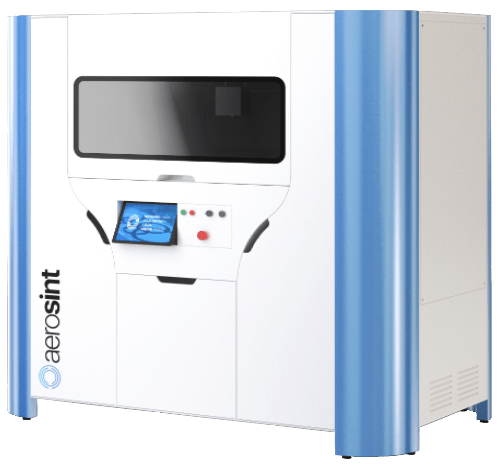3D printed polymers could potentially replace metals in multiple applications, such as in the aerospace and medical fields. However, expensive material waste issues are slowing down the development and widespread adoption of high-performance plastics. Belgian startup Aerosint has a very different approach to multi-material powder deposition, in that it selectively deposits powder material from a rotating drum that passes over a build area. This mechanical system replaces the normal powder recoater in SLS and SLM 3D printers, so that two or more ceramic, metal, or polymer powders can be deposited in one layer with spatial selectivity.
Last month, Aerosint partnered up with Aconity3D to advance multi-metal 3D printing applications, and now it’s announced a new research collaboration agreement with advanced materials and specialty chemicals company Solvay, which is also headquartered in Belgium. Together, the two companies will work to develop an SLS 3D printing process for specialty high-performance polymers that’s economically viable.
“SLS machines that can process high-temperature-polymers are carefully designed and assembled with sophisticated and expensive components. However, at present, there is a significant operating cost disadvantage during the build, which is the excessive waste of up to 90 percent of ‘used-but-unfused’ powder. Our patented spatially-selective, multiple-powder deposition system under development incorporates a non-fusible support material in each layer where expensive high-performance polymers are not required, thereby reducing material waste to very low levels,” said Edouard Moens, the Managing Director of Aerosint.
 Aerosint, established in 2016, employs seven people, and is a spinoff company from the startup studio M4KE.IT Group. So it’s a big step up for the company to partner with the Brussels-based Solvay, which employs about 27,000 people in over sixty countries around the world.
Aerosint, established in 2016, employs seven people, and is a spinoff company from the startup studio M4KE.IT Group. So it’s a big step up for the company to partner with the Brussels-based Solvay, which employs about 27,000 people in over sixty countries around the world.
Solvay is deeply committed to developing chemistry that will address important societal challenges; for example, its performance chemicals improve air and water quality, while its formulations optimize resource use and its lightweighting materials promote cleaner mobility. At last year’s RAPID + TCT event, the company launched the first high-performance filaments – PEEK, PPSU, and CF – for FFF 3D printing, which was a big step forward for high-performance 3D printing.
High-performance polymers from Solvay, like its Ryton polyphenylene sulphide (PPS) and KetaSpire PEEK, could potentially lead the way in introducing demanding applications in 3D printing. But, the adoption of these materials with important powder fusion processes, like SLS, is still limited.
“As with all innovative, ground-breaking technologies there are many challenges to overcome. One of them is to develop and fully optimize high-performance AM polymer powders for use at high temperatures alongside non-fusible materials in a multi-powder deposition process. Not only will this technology make 3D printing of high-performance polymers more affordable, it also will open up its enormous potential to become a competitive industrial process for AM system manufacturers in the medical, aerospace and automotive sectors,” said Brian Alexander, the Global Product and Application Manager for Additive Manufacturing at Solvay’s Specialty Polymers global business unit.
 Aerosint and Solvay have actually already been cooperating for more than two years to offer each other support, along with advanced fusion, material, and process expertise, in their ongoing joint efforts to develop this high-performance material technology. This newly announced research collaboration agreement is just the next step.
Aerosint and Solvay have actually already been cooperating for more than two years to offer each other support, along with advanced fusion, material, and process expertise, in their ongoing joint efforts to develop this high-performance material technology. This newly announced research collaboration agreement is just the next step.
Discuss this story and other 3D printing topics at 3DPrintBoard.com or share your thoughts in the Facebook comments below.
Subscribe to Our Email Newsletter
Stay up-to-date on all the latest news from the 3D printing industry and receive information and offers from third party vendors.
You May Also Like
Precision at the Microscale: UK Researchers Advance Medical Devices with BMF’s 3D Printing Tech
University of Nottingham researchers are using Boston Micro Fabrication‘s (BMF) 3D printing technology to develop medical devices that improve compatibility with human tissue. Funded by a UK grant, this project...
3D Printing Webinar and Event Roundup: April 21, 2024
It’s another busy week of webinars and events, starting with Hannover Messe in Germany and continuing with Metalcasting Congress, Chinaplas, TechBlick’s Innovation Festival, and more. Stratasys continues its advanced training...
3D Printing Webinar and Event Roundup: March 17, 2024
It’s another busy week of webinars and events, including SALMED 2024 and AM Forum in Berlin. Stratasys continues its in-person training and is offering two webinars, ASTM is holding a...
3D Printed Micro Antenna is 15% Smaller and 6X Lighter
Horizon Microtechnologies has achieved success in creating a high-frequency D-Band horn antenna through micro 3D printing. However, this achievement did not rely solely on 3D printing; it involved a combination...































